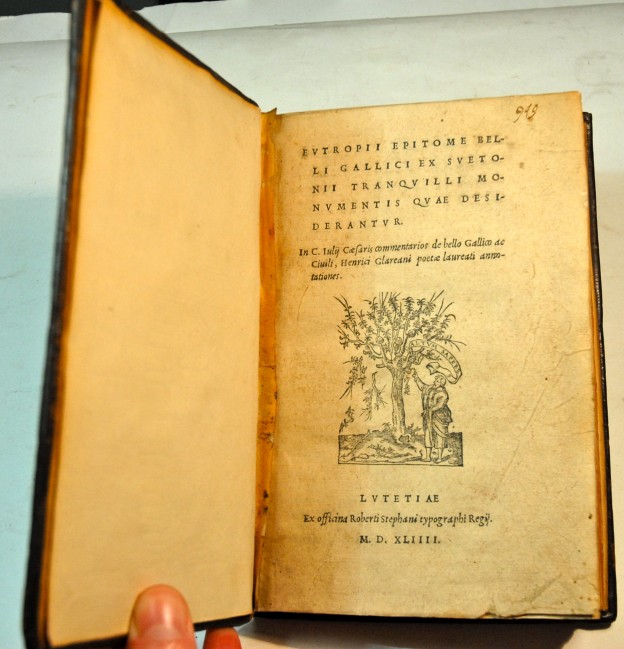EUTROPIUS
Epitome Belli Gallici
Paris, Robert Estienne, 1544£3,750.00
FIRST EDITION, 8vo., pp [ii] 3-134 [civ]. Mostly Italic, some Roman letter, a little Greek. Estienne’s woodcut Noli Alterum Sapere device on t-p, woodcut diagram in text. Early ms. price mark (?) on t-p, contemp ms. annotation to K4. In a very handsome contemporary calf binding, covers ruled and panelled in blind, central section within border of ornate flowers and garlands, two medallion heads on panel within, vellum stubbs. Lower cover with single but significant diagonal crack, very small repairs at head & tail of spine. A good, clean copy with wide margins, a.e.r.
The impressive contemp. calf binding of this copy strongly resembles Oldham HM23 “only one example is known” and is almost certainly English, though “many of the panels used in England no doubt came from the Netherlands” (Oldham p. 20). The text itself consists of a brief summary – the Epitome – of the Gallic Wars, taken from Suetonius’ iconic work. Eutropius was a late Roman historian and secretary (magister memoriae) at Constantinople. Written in a straightforward narrative style, with none of the syntactical twists and turns of Suetonius’ original Latin, the text rattles through the most important campaigns waged by Julius Caesar during the Gallic and Civil Wars, moving on to his Dictatorship and death at the hands of the Senate in only a few pages. This is followed by notes on the Commentary on Caesar’s Gallic and Civil Wars, by Henricus Glareanus: these consist of short summaries of each book and explanations of any obscure place names or peoples (e.g. the tribe known as the Sedusi who, Glareanus tells us, ‘non sunt Seduni see Germani’, referencing Pliny 4.17. Glareanus also explains, with a diagram, Caesar’s battle formation, and the various numbers of his troops. The work ends with four alphabetical indexes: the first refers back to Glareanus’ annotations on the commentary, the second gives the French equivalents of Roman place names and tribes mentioned in Caesar’s text; the third, longer notes on these places and tribes, and the fourth is an index of Caesar’s text itself. This beautifully bound edition must have been a very handy condensed textbook for any student of Caesar who had neither the time nor the inclination for the original work.
Renouard 60:13. Adams E1133 + pt C38. See also Goldschmidt LI.In stock





